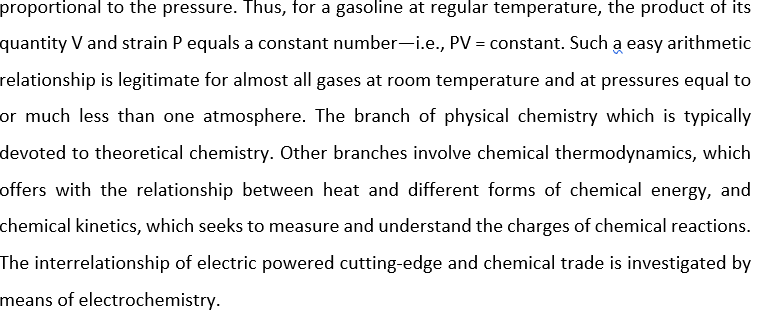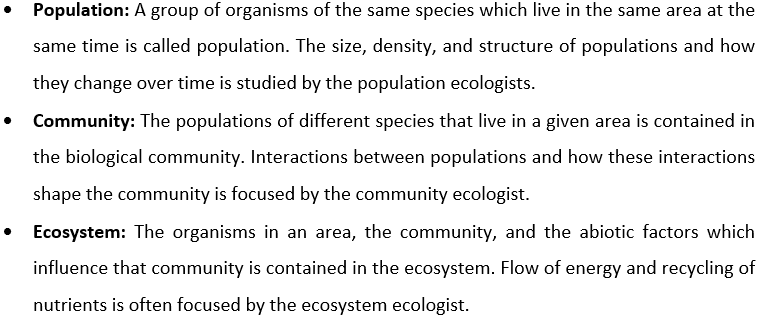Ecology manages the life form and its condition
The science which deals with the properties, composition, and shape
of substances, the modifications they experience, and the electricity
that is discharged or retained for the duration of these strategies is
known as chemistry. Each substance, regardless of whether naturally
happening or artificially produced, comprises of at least one of the
hundred-odd types of atoms that have been diagnosed as components. Some
lessons of materials which share with the frequent structural and
chemical aspects in many disciplines of chemicals. To correlate,
measure, and explain the chemical quantitative factors tactics is
completed by the physical chemistry. For example, the volume of a fixed
volume of gasoline is inversely 
_________________________________________________________________
State of matter: Elements which has state of matter as solids, liquids or gas at standard temperature and pressure.
Melting and boiling points
Figure 1 Periodic Table of Elements
The most abundant elements in the universe are Helium and Hydrogen. The most abundant element (by mass) in the composition of the Earth is Iron, and the most common element in the layer that is the Earth’s crust is oxygen.
Organisms: Study of adaptations, valuable features emerging naturally, which allows the living beings to live in specific environments is called organisms. These adaptations can be physiological, morphological and behavioral.

Q.4) Environmental Sciences
Ans: The learn about of the results of natural and unnatural processes, and of interactions of the bodily elements of the planet on the environment is known as environmental sciences.
Importance of Environmental Science are as follows:
To understand that environmental problems are universal
To study and create awareness about environmental problems at local, national and international levels.
Q.5) Earth’s material
as a medium for plant growth
as a modifier of Earth's atmosphere
Q.6) Chemical Kinetics
Ans: The branch of bodily chemistry which is worried with grasp the costs of chemical reactions is recognized as chemical kinetics. It is to be compared with thermodynamics, that deals with the course in a method however no longer with its rate. Chemical kinetics relates to a range of characteristics of geology, cosmology, biology, engineering, and even psychology. The ideas of chemical kinetics can be utilized to in basic terms physical strategies as well as to chemical reactions.
The charges with which the merchandise are shaped and the reactants are bump off is acknowledged as response rate. For chemical systems, it is frequent to deal with the concentrations of substances, that is referred to the quantity of substance per unit volume. The charge can be defined as the awareness of a substance ate up or produced in unit time. Factors which affects the response rate are as follows: Nature of reactants; Physical state; Surface region of solids; Concentration; Temperature; Catalyst; Pressure.
___________________________________________________________________________
Temperature: -The average kinetic power of the particles in a system is measured and expressed in gadgets of degree Celsius or Kelvin or Fahrenheit on a popular scale.
Specific Heat: - The amount of warmness required to increase the temperature of a body via positive quantity is referred to as specific heat.
Second law of thermodynamics: - It states that heat energy cannot be transferred from a physique at a decrease temperature to a physique at a greater temperature without the addition of energy.
Third law of thermodynamics: - It states that the entropy of a ideal crystal of an component in its most secure form tends to zero as the temperature techniques absolute zero.
• Chemical test: Various qualitative test can be performed such as acid check for gold, etc.
• Flame test: A systematic scheme to affirm the presence of positive aqueous ions or elements through performing a series of reactions that remove stages of probabilities and then confirms suspected ions with a confirming take a look at is called flame test.
Error: Numerical difference between true value and observed value is defined as the Error.
$\varepsilon_{a}\ = \ \left| x - \ \overline{x} \right|$
Q.9) Petrology
Ans: The study of rocks which deals with their texture, composition, and structure; their occurrence and distribution; and their origin in relation to physical & chemical conditions and geologic processes is known as petrology. It is corelated with all three major types of rocks i.e. igneous, metamorphic, and sedimentary.
Ans: The study of minerals, their crystalline and chemical structures, and their properties such as melting factors is acknowledged as mineralogy. The primary materials of rocks and ore deposits are minerals.
The study of mineralogy includes vast ranging from the rationalization and arrangement of a new or uncommon mineral, analysis of crystal shape which involves calculation of its inside atomic arrangement, or to the laboratory or industrial synthesis of mineral species at high temperatures and pressures. The techniques employed in such research are equally different and encompass simple physical and chemical identification tests, dedication of crystal symmetry, optical examination, X-ray diffraction, isotopic analysis, and other state-of-the-art procedures.
Encyclopedia Britannica. (2019). chemistry | Definition, Topics, & History. [online] Available at: https://www.britannica.com/science/chemistry [Accessed 2 Jul. 2019].
Chemicool.com. (2019). Definition of element - Chemistry Dictionary. [online] Available at: https://www.chemicool.com/definition/element.html [Accessed 2 Jul. 2019].
Encyclopedia Britannica. (2019). physical science | Definition, History, & Topics. [online] Available at: https://www.britannica.com/science/physical-science [Accessed 2 Jul. 2019].
Science, L. (2019). What is Thermodynamics? [online] Live Science. Available at: https://www.livescience.com/50776-thermodynamics.html [Accessed 2 Jul. 2019].
